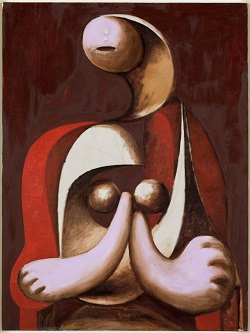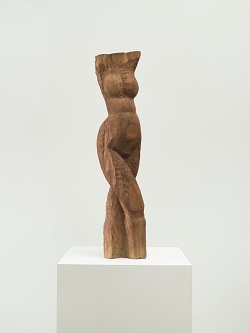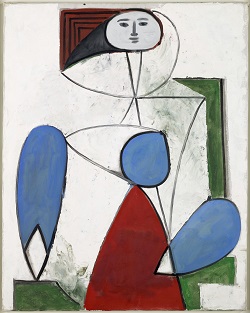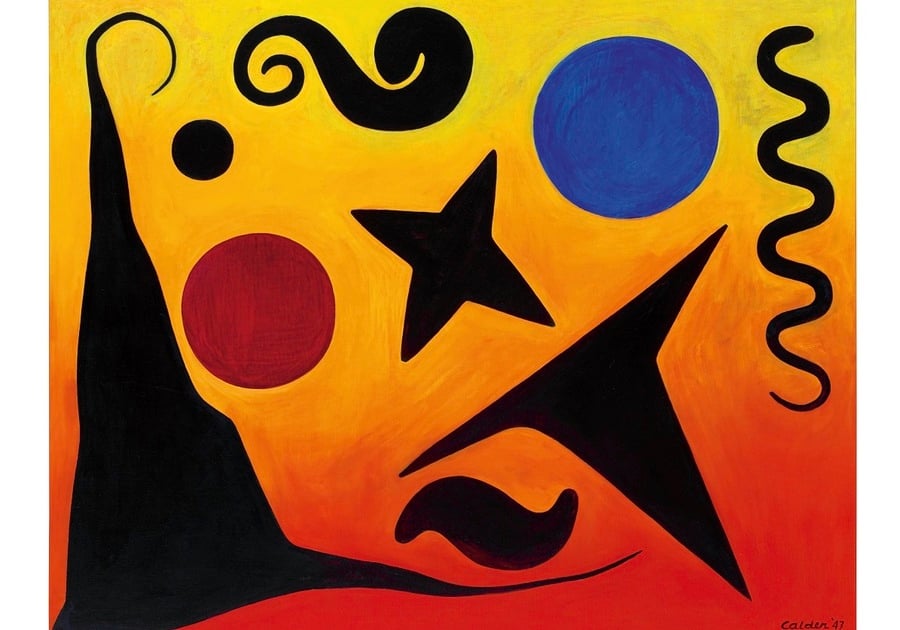Alexander Calder and Pablo Picasso are two of the foremost figures in the history of 20th-century art. The touring exhibition “Calder-Picasso,” which debuted at the Musée national Picasso-Paris and comes to the High Museum of Art this summer (June 26-Sept. 19), reveals the radical innovations and enduring influence of these two artists through more than 100 paintings, sculptures and works on paper spanning their careers.
Conceived by the artists’ grandsons, Bernard Ruiz–Picasso and Alexander S. C. Rower, and organized by the Museum of Fine Arts, Houston, the exhibition focuses on the two artists’ exploration of the void, or the absence of space, which both artists defined from the figure through to abstraction. Calder and Picasso wanted to present or represent non-space, whether by giving definition to a subtraction of mass, as in Calder’s sculptures, or by expressing contortions of time, as in Picasso’s portraits. Calder’s early wire figures (“drawings in space”), paintings, drawings, and revolutionary nonobjective mobiles, stabiles and standing mobiles are integrated throughout the exhibition with profoundly inventive works by Picasso in every media. The juxtapositions are insightful and challenging, demonstrating the striking innovations by these great artists who ceaselessly reexamined their ideas about form, line and space.
“Calder and Picasso are among the most consequential artists of the 20th century,” said Rand Suffolk, the High’s Nancy and Holcombe T. Green, Jr., director. “Their work remains undeniably compelling, and although we’ve presented it separately on many occasions, this exhibition offers the chance to see it from a particularly unique perspective.”
The High’s Frances B. Bunzl Family Curator of European Art Claudia Einecke noted, “‘Calder-Picasso’ is not a pairing that springs to mind readily – personal contact between the two artists was minimal. And yet, their iconic sculptures, paintings and drawings, when seen side by side and across from each other, as they are in the exhibition, show strong conceptual and formal affinities. In fact, we might think of the exhibition as a kind of non-verbal version of the artistic conversation that Calder and Picasso, by all accounts, did not have in person.”
The exhibition is arranged in thematic sections that explore the concepts, constructions and creative processes connecting the artists’ work, as well as the rare but consequential times their lives intersected.
 |  |  |
Calder and Picasso
Alexander Calder (American, 1898-1976) and Pablo Picasso (Spanish, 1881-1973) were both born in the late 19th century to fathers who were classically trained artists. Though their lives and work share many parallels, the two icons of modernism were not close, reportedly meeting only four times. They first met in April 1931 when Calder presented his first exhibition of nonobjective sculptures at Galerie Percier in Paris; Picasso arrived before the opening to introduce himself and view Calder’s works. Their paths crossed again in July 1937 at the Spanish Pavilion of the Exposition Internationale in Paris, where Calder’s “Mercury Fountain” was installed in front of Picasso’s “Guernica.” Each artist was later given a retrospective at the Museum of Modern Art in New York, Picasso in 1940 and Calder in 1943. Then, in the early 1950s, they crossed paths on the Côte d’Azur.
The Void and Non-Space
The exhibition takes an in-depth look at how both Calder and Picasso were captivated by the relationship of volume to space.
Calder explored the absence of mass in his sculptures, an approach that was entirely unprecedented. His figurative wire sculptures — or “drawings in space” — capture the vitality and energetic forces of their subjects and form transparent silhouettes, echoed by the shadows they project on the wall. In 1931, he invented an entirely new type of art — purely abstract sculptures that could be set in motion. Marcel Duchamp named them “mobiles,” which in French refers to both “motive” and “motion.” These works introduce the fourth dimension of time into three-dimensional space and redefine the traditional relationship between volume and the void.
Picasso’s exploration of non-space included experimentations with wire sculpture as well as figure paintings and sculptures simplified through abstract shapes and lines. He personalized his expressions of the void by exploring psychology and emotions, removing the interpersonal space between painter and subject, and by investigating mortality, like in the oil on canvas “Vanité” (1946) and a graveside sculpture he created for his friend, the poet Guillaume Apollinaire.
 | Want To Save Time Looking for Things to Do with Your Kids? Our Family Event Calendar is packed full of events, festivals, fairs, story times, and awesome local family fun. We proudly serve families in Tyrone, Fayetteville, Senoia, Sharpsburg, Brooks, Newnan and Peachtree City! Sign-up for FREE by clicking HERE. |



